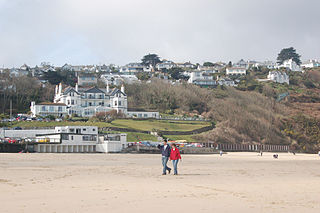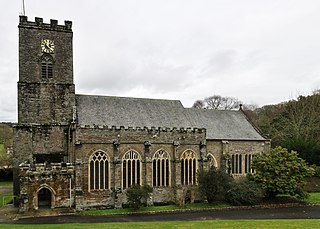Related Research Articles

Piran or Pyran, died c. 480, was a 5th-century Cornish abbot and saint, possibly of Irish origin. He is the patron saint of tin-miners, and is also generally regarded as the patron saint of Cornwall, although Michael and Petroc also have some claim to this title.

Carbis Bay is a seaside resort and village in Cornwall, England. It lies 1 mile (1.6 km) southeast of St Ives, on the western coast of St Ives Bay, on the Atlantic coast. The South West Coast Path passes above the beach.

Michael Joseph, better known as Michael An Gof, was one of the leaders of the Cornish rebellion of 1497, along with Thomas Flamank.

St Keverne is a civil parish and village on The Lizard in Cornwall, England, United Kingdom.

The Cornish rebellion of 1497, also known as the First Cornish rebellion, was a popular uprising in the Kingdom of England, which began in Cornwall and culminated with the Battle of Deptford Bridge near London on 17 June 1497.

The culture of Cornwall forms part of the culture of the United Kingdom, but has distinct customs, traditions and peculiarities. Cornwall has many strong local traditions. After many years of decline, Cornish culture has undergone a strong revival, and many groups exist to promote Cornwall's culture and language today.
Charles Gordon Henderson was a Cornish historian and antiquarian.

Ludgvan is a civil parish and village in Cornwall, England, UK, 2+1⁄2 miles (4 km) northeast of Penzance. Ludgvan village is split between Churchtown, on the hill, and Lower Quarter to the east, adjoining Crowlas. For the purposes of local government, Ludgvan elects a parish council every four years; the town elects a member to Cornwall Council under the Ludgvan division.
Felec or Felix was an obscure 5th- or 6th-century British saint active in Cornwall. The church of St Felicitas and St Piala's Church, Phillack near Hayle is dedicated to Saint Felec. Later generations mistook him for the female Saint Felicity of Rome.

March 4 - Eastern Orthodox liturgical calendar - March 6

Manaccan is a civil parish and village on the Lizard peninsula in south Cornwall, England, United Kingdom. The village is about five miles (8 km) south-southwest of Falmouth.

Phillack is a village now in the parish of Hayle, in west Cornwall, England. It is about one mile (1.6 km) northeast of Hayle and half-a-mile (0.8 km) inland from St Ives Bay on Cornwall's Atlantic Ocean coast. The village is separated from the sea by a range of high sand dunes known as The Towans.

Cubert is a village in Cornwall, England, United Kingdom. It is three miles (5 km) south-southwest of Newquay and is in the civil parish of Cubert.

Probus is a civil parish and village in Cornwall, England, in the United Kingdom. It has the tallest church tower in Cornwall. The tower is 129 feet (39 m) high, and richly decorated with carvings. The place name originates from the church's dedication to Saint Probus. The parish population at the 2011 census was 2,299, whereas the ward population taken at the same census was 3,953.

Melor was a 10th-century Breton saint who, in England, was venerated in Cornwall and at Amesbury Abbey, Wiltshire, which claimed some of his relics.
Branwalator or Breward, also referred to as Branwalader, was a British saint whose relics lay at Milton Abbas in Dorset and Branscombe in Devon. Believed to come from Brittany, he also gives his name to the parish of Saint Brélade, Jersey. "Brelade" is a corruption of "Branwalader". He is also known as Breward or Branuvelladurus or Brélade and Broladre in French.

Christianity in Cornwall began in the 4th or 5th century AD when Western Christianity was introduced as in the rest of Roman Britain. Over time it became the official religion, superseding previous Celtic and Roman practices. Early Christianity in Cornwall was spread largely by the saints, including Saint Piran, the patron of the county. Cornwall, like other parts of Britain, is sometimes associated with the distinct collection of practices known as Celtic Christianity but was always in communion with the wider Catholic Church. The Cornish saints are commemorated in legends, churches and placenames.
Indract or Indracht was an Irish saint who, along with his companions, was venerated at Glastonbury Abbey, a monastery in the county of Somerset in south-western England. In the High Middle Ages Glastonbury tradition held that he had been an Irish pilgrim — a king's son – on his way back from Rome who was molested and killed by a local thegn after he had stopped off to visit the shrine of St Patrick. This tradition synchronised his life with that of King Ine (688–726), though historian Michael Lapidge has argued that he is most likely to represent a 9th-century abbot of Iona named Indrechtach ua Fínnachta.

The Meneage is a district in west Cornwall, United Kingdom. The nearest large towns are Falmouth and Helston.

Tregidden is a hamlet south of Manaccan in Cornwall, England, United Kingdom. A little further south is Tregidden Farm. Tregidden is located in the parish of St Martin-in-Meneage and also partly in the parishes of Manaccan and St Keverne.
References
- ↑ "St Kerrian's Church, North Street". February 26, 2011.
- ↑ Olson, B. Lynette, “The tenth-century List of Cornish parochial saints’ names in Codex Vaticanus Reg. lat. 191”, Parergon 13:2 (January, 1996): 179–181.
- ↑ Robert Hunt, Popular Romances of the West of England, 1881, pp.262-4.